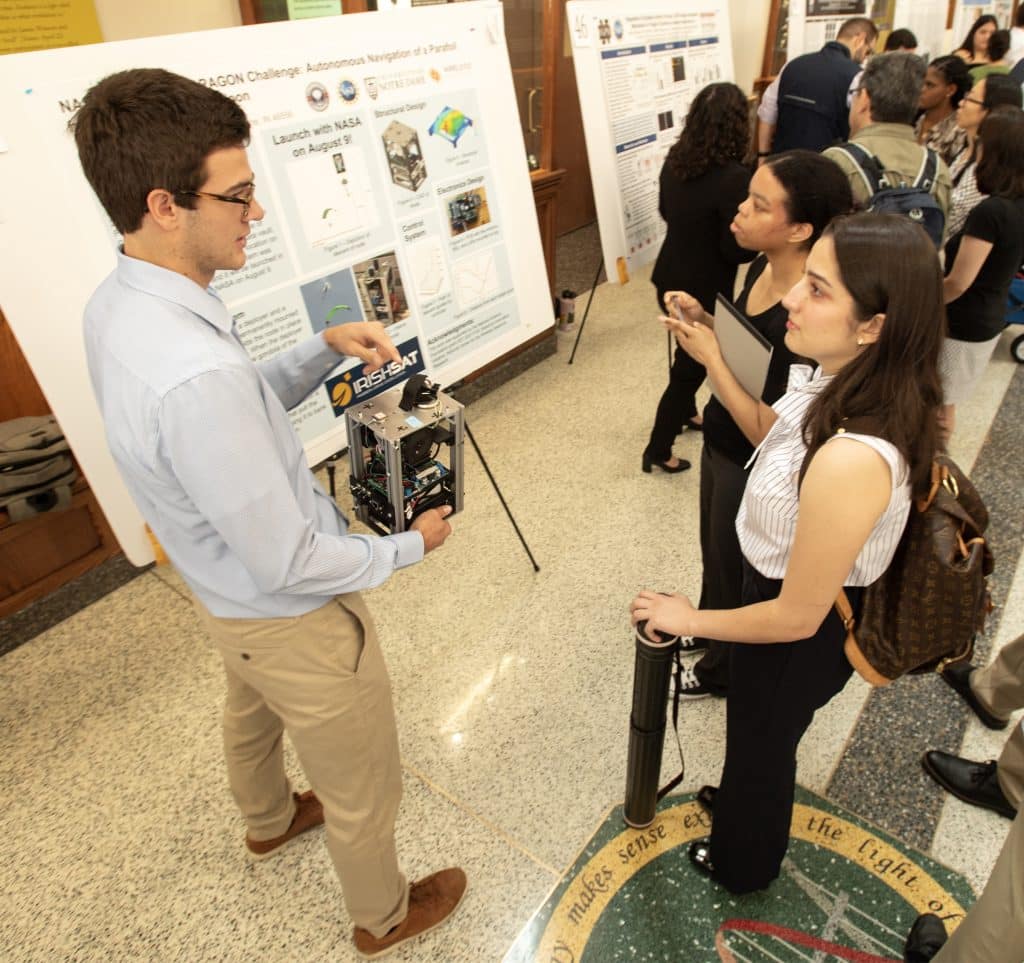By Christina Clark
Four students who participated in the Advanced Wireless Research Experiences (AWaRE) program, sponsored by the University of Notre Dame’s Wireless Institute and SpectrumX, presented research posters on July 26.
The four AWaRE REU students included:
- Samuel Clough, student at Andrews University, presented Millimeter-Wave Measurement and Modeling of High-Speed Transistors
- Ryan Murray, student at the University of Notre Dame, presented Collaborative Intelligent Radio Systems for Congested Wireless Environments / Spectrum Coexistence Technologies and Policies for Interfering Radio Systems
- Patrick Schwartz, student at the University of Notre Dame, presented on IrishSat
- Allen Jeremy Uy, student at the University of Notre Dame, presented Machine Learning Methods for Modeling Spectrum Occupancy
Each student chose their own topic to research throughout the program and presented their projects at the end of their onsite experiences through the summer during the 2023 Summer Undergraduate Research Symposium hosted at the University of Notre Dame.

Ryan Murray studied with SpectrumX center director and professor in the Department of Electrical Engineering, Nick Laneman. Murray said that he became interested in the electrical engineering field of study through some of his coursework.
“I am interested in emerging technology and its impacts on existing structures, so looking into how 5G impacts existing radiometers fits into that interest. I found it motivating that I could take what I learned and apply it to this field,” he said. Murray reflected on the experience and said that Laneman guided him through the research process by introducing him to the problems and questions that Murray could investigate and ensuring he had information for each aspect to ensure it was an interesting topic to him.
“As the program progressed, my faculty advisor helped me through sections of the work that I found confusing or unfamiliar,” said Murray.
Allen Jeremy Uy, who studied with SpectrumX Project Team-Sensing lead and professor in the Department of Electrical Engineering Bertrand Hochwald, and professor in the Department of Electrical Engineering Michael Lemmon, found the summer experience to be a valuable opportunity to explore his several topics.

“The most interesting part about the REU experience is the freedom and responsibility you are given when doing research compared to other job roles where your goals are more defined. This gave me the opportunity to continuously switch around my research as I learned more and had a better understanding of what I was doing, what tools are out there, and what I could further explore in the field,” said Uy. “This makes me excited to be working in different research opportunities later on in my undergraduate experience knowing how much I can learn and have the experience of trying to do things not done before.”
Patrick Schwartz, who studied with electrical engineering professor Scott Howard, enjoyed his REU with IrishSat, which is Notre Dame’s chapter of NASA’s CubeSat Launch Initiative. Students participating in IrishSat conduct research in a low-orbit environment.
“I would tell other students that it was an amazing opportunity and experience. You have a lot of freedom to explore and research what you want on your own, under the guidance of a faculty advisor that is helping you and teaching you a ton,” said Schwartz.

At the end of the symposium, a Three Minute Thesis-style competition was held for students on topics including electrical engineering, biomedical engineering, chemistry and more. Each student was given three minutes to give their abstract and thesis statements, trying to get close to filling the three minutes, but not go over the time. One student in the AWaRE program, Allen Jeremy Uy, participated in the challenge.
The research symposium allowed students to speak about their research with faculty and other researchers involved in summer programs from multiple disciplines across the University of Notre Dame.
Students interested in undergraduate and graduate research opportunities with SpectrumX researchers are encouraged to visit the SpectrumX website to learn about opportunities and submit the Get Involved form to get in touch.
Image captions: First image, Top Right: AWaRE REU researcher Ryan Murray, student at the University of Notre Dame, presented Collaborative Intelligent Radio Systems for Congested Wireless Environments / Spectrum Coexistence Technologies and Policies for Interfering Radio Systems Second image, Left: AWaRE REU researcher Samuel Clough, student at Andrews University, presented Millimeter-Wave Measurement and Modeling of High-Speed Transistors; Third Image, Center: AWaRE REU researcher Allen Uy, student at the University of Notre Dame, presented Machine Learning Methods for Modeling Spectrum Occupancy; Bottom Left: AWaRE REU researcher Patrick Schwartz, student at the University of Notre Dame, presented on IrishSat.
Images by Wes Evard, University of Notre Dame.
About SpectrumX
SpectrumX is funded by the National Science Foundation (NSF) as part of its Spectrum Innovation Initiative, under grant number AST 21-32700. SpectrumX is the world’s largest academic hub where all radio spectrum stakeholders can innovate, collaborate, and contribute to maximizing social welfare of this precious resource.
To learn more about SpectrumX, please visit spectrumx.org.
Contact:
Christina Clark, Research Communications Specialist
SpectrumX / Notre Dame Research / University of Notre Dame
cclark26@nd.edu / 574.631.2665
spectrumx.org

